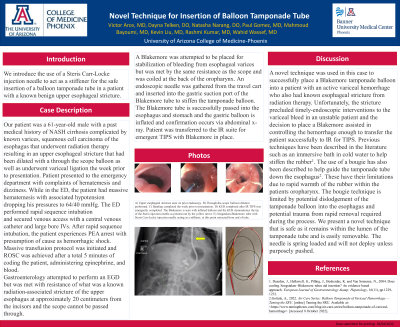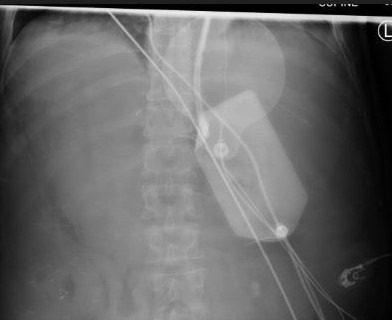Back


Poster Session B - Monday Morning
Category: GI Bleeding
B0335 - Novel Technique for Insertion of Balloon Tamponade Tube
Monday, October 24, 2022
10:00 AM – 12:00 PM ET
Location: Crown Ballroom

Has Audio
- VA
Victor Arce, MD
University of Arizona College of Medicine
Phoenix, AZ
Presenting Author(s)
Victor Arce, MD1, Dayna M. Telken, DO1, Natasha Narang, DO1, Paul Gomez, MD1, Mahmoud Bayoumi, MD, MPH2
1University of Arizona College of Medicine, Phoenix, AZ; 2Banner University Medical Center, Phoenix, AZ
Introduction: We introduce the use of an endoscopic injection needle to act as a stiffener for the safe insertion of a balloon tamponade tube in a patient with a known benign upper esophageal stricture.
Case Description/Methods: 61 year old male with a past medical history of NASH cirrhosis complicated by known varices, squamous cell carcinoma of the esophagus that underwent radiation therapy resulting in a known upper esophageal sphincter that had been dilated with a through the scope balloon the week prior, presented to the emergency department with complaints of hematemesis and dizziness While in the ED, the patient begins to have massive hematemesis with associated hypotension dropping his pressures to 64/40 mmHg. The ED performs rapid sequence intubation and begins securing venous access with a central venous catheter and large bore IVs. After RSI, the patient experiences PEA arrest with presumption of cause as hemorrhagic shock. Massive transfusion protocol is initiated and. ROSC is achieved after a total 5 minutes of coding the patient, administering epinephrine, and blood.
Gastroenterology attempts to perform an EGD but is met with resistance of what is a known radiation-associated stricture off the upper esophagus at approximately 20 centimeters from the incisors and the scope cannot be passed through. A blakemore is attempted to be placed for stabilization of bleeding from esophageal varices but is met by the same resistance as the scope and is coiled at the back of the oropharynx. An endoscopic needle is gathered from the travel cart and inserted into the gastric suction port of the Blakemore tube in order to stiffen the tamponade balloon. The Blakemore tube is successfully passed into the esophagus and stomach and the gastric balloon is inflated and confirmation occurs via abdominal x-ray. Patient is transferred to the IR suite for emergent TIPS with Blakemore in place.
Discussion: A novel technique was used in this case to successfully place a Blakemore tamponade balloon into a patient with an active variceal hemorrhage who also had known esophageal stricture from radiation therapy. Unfortunately the stricture precluded timely-endoscopic interventions to the variceal bleed in an unstable patient and the decision to place a Blakemore assisted in controlling the hemorrhage enough to transfer the patient successfully to IR for TIPS.

Disclosures:
Victor Arce, MD1, Dayna M. Telken, DO1, Natasha Narang, DO1, Paul Gomez, MD1, Mahmoud Bayoumi, MD, MPH2. B0335 - Novel Technique for Insertion of Balloon Tamponade Tube, ACG 2022 Annual Scientific Meeting Abstracts. Charlotte, NC: American College of Gastroenterology.
1University of Arizona College of Medicine, Phoenix, AZ; 2Banner University Medical Center, Phoenix, AZ
Introduction: We introduce the use of an endoscopic injection needle to act as a stiffener for the safe insertion of a balloon tamponade tube in a patient with a known benign upper esophageal stricture.
Case Description/Methods: 61 year old male with a past medical history of NASH cirrhosis complicated by known varices, squamous cell carcinoma of the esophagus that underwent radiation therapy resulting in a known upper esophageal sphincter that had been dilated with a through the scope balloon the week prior, presented to the emergency department with complaints of hematemesis and dizziness While in the ED, the patient begins to have massive hematemesis with associated hypotension dropping his pressures to 64/40 mmHg. The ED performs rapid sequence intubation and begins securing venous access with a central venous catheter and large bore IVs. After RSI, the patient experiences PEA arrest with presumption of cause as hemorrhagic shock. Massive transfusion protocol is initiated and. ROSC is achieved after a total 5 minutes of coding the patient, administering epinephrine, and blood.
Gastroenterology attempts to perform an EGD but is met with resistance of what is a known radiation-associated stricture off the upper esophagus at approximately 20 centimeters from the incisors and the scope cannot be passed through. A blakemore is attempted to be placed for stabilization of bleeding from esophageal varices but is met by the same resistance as the scope and is coiled at the back of the oropharynx. An endoscopic needle is gathered from the travel cart and inserted into the gastric suction port of the Blakemore tube in order to stiffen the tamponade balloon. The Blakemore tube is successfully passed into the esophagus and stomach and the gastric balloon is inflated and confirmation occurs via abdominal x-ray. Patient is transferred to the IR suite for emergent TIPS with Blakemore in place.
Discussion: A novel technique was used in this case to successfully place a Blakemore tamponade balloon into a patient with an active variceal hemorrhage who also had known esophageal stricture from radiation therapy. Unfortunately the stricture precluded timely-endoscopic interventions to the variceal bleed in an unstable patient and the decision to place a Blakemore assisted in controlling the hemorrhage enough to transfer the patient successfully to IR for TIPS.

Figure: Tamponade balloon with visible endoscopic needle in gastric suction channel.
Disclosures:
Victor Arce indicated no relevant financial relationships.
Dayna Telken indicated no relevant financial relationships.
Natasha Narang indicated no relevant financial relationships.
Paul Gomez indicated no relevant financial relationships.
Mahmoud Bayoumi indicated no relevant financial relationships.
Victor Arce, MD1, Dayna M. Telken, DO1, Natasha Narang, DO1, Paul Gomez, MD1, Mahmoud Bayoumi, MD, MPH2. B0335 - Novel Technique for Insertion of Balloon Tamponade Tube, ACG 2022 Annual Scientific Meeting Abstracts. Charlotte, NC: American College of Gastroenterology.
